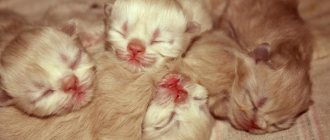Childbirth is the process of the appearance of offspring, established by nature in most animals. If your pet becomes pregnant, you should find out in advance how cats give birth. After all, your pet may need your help at the time of labor, especially if any complications begin. In addition, the cat and its offspring will definitely need care after giving birth. And the owner must provide them with all this.
Signs of labor in a cat
The owner of this type of mammal should know how to understand that a cat is giving birth. Veterinarians have identified several signs of imminent labor:
Advertising:
- 2-3 days before birth, the body temperature of the expectant mother drops to 37°C;
- and the mammary glands, on the contrary, become hotter and swell, this is due to the fact that they are actively producing a nutritional mixture for kittens;
- 2 days before the start, the pet’s genitals swell and become pinkish;
- a few hours before the start, the cat begins to actively lick itself;
- the pet’s activity decreases, it becomes apathetic, it is better not to disturb it during this period;
- the day before giving birth, the cat completely stops eating food, however, it must be fully provided with drink;
- a few hours before giving birth, the cat practices “training”, that is, it begins to arch, as if during contractions, from this moment it is better to be near it constantly;
- if the pet is attached to the owner, then she will constantly follow him and meow loudly, since she is not comfortable and requires support and help.
Preparing for childbirth
If according to signs the cat is expected to give birth within the next 24 hours, then you definitely need to prepare for this. It’s better to do this in advance, a few days in advance, so that everything is at hand. All preparation is carried out in several stages.
Preparing the birth site
The expectant mother must get used to the parenting place in advance. Therefore, the box in which the birth will take place should appear in the house at least a week before the significant event. If this is not done, the pet will choose its own place. This could be a closet or just a secluded corner. At the same time, it is almost impossible to convince the pet to move into the box in this case.
Box requirements:
- the cat should be able to stretch out to its full height inside, and at the same time there should be enough space for the kittens;
- the height of the container should be approximately half a meter;
- the exit must be made in such a way that the mother can calmly get out and go back in, but the kittens cannot;
- A small soft pillow should be placed on the bottom, which should be wrapped in a waterproof cloth, and an absorbent cloth should be placed on top.
If before giving birth the cat did not enter the prepared house on its own, then it should be carried and placed inside. At the same time, she needs to be stroked and calmed down, and made to understand that it is better to give birth to offspring here.
Preparing tools
Owners should have everything they need on hand:
- lots of rags;
- several pairs of sterile gloves;
- sterile bandages and napkins;
- surgical thread for tying the umbilical cord; a couple of hours before birth, they should be placed in a container with alcohol for disinfection;
- small scissors with rounded ends;
- a baby syringe, which will be needed to suck out liquid from the nose or mouth;
- scales, a writing object, blank paper, a watch to record and record all events;
- disposable syringes;
- a garbage bag to store used materials and tools.
Medications
Stock up on a small first aid kit, which should contain:
- hydrogen peroxide;
- brilliant green or potassium permanganate;
- alcohol, cognac or other alcoholic drink;
- oxytocin.
Social skills
You can accustom kittens to handling and interacting with children from the 2nd to the 7th week. If the mother cat reacts aggressively to this, simply put the kitten back in place and try again in a couple of days; as the kittens get older, their mother's aggression will disappear.
Be careful when handling a newborn kitten. If there are children in the house, teach them the rules of handling animals and prohibit taking kittens from the nest when there are no adults in the room.
How does childbirth occur in cats?
You can determine that your cat will go into labor in the next few hours by looking at the contractions.
Moreover, the closer hour X is, the stronger they become. In general, if everything goes smoothly, according to the rules laid down in nature, then you won’t even have to give birth. But just in case, it is better to stay with your pet until the end. Many owners may also be interested in how many kittens a cat can give birth to. In general, such an animal is capable of giving birth to almost any number of kittens. For example, there have been cases when one cat gave birth to one kitten, and another 14. If we take the average, then cats give birth to approximately 4-7 kittens at a time.
First birth of a cat
If the cat has not given birth before, this means that double attention to the mother will be required during the process. The first birth does not require any special preparation. But it’s worth repeating once again that you should carefully observe the process itself and be ready to help your four-legged friend, since due to inexperience she may get confused.
How to prepare a cat for childbirth?
It is only possible to prepare a cat for childbirth, if it does not have any abnormalities, only morally. It’s worth trying to pet her and calm her down. But if the cat doesn’t give in, tries to run away, scratch or bite, then it’s better not to touch it.
If spasms, that is, contractions of the uterus, can be felt by placing your palm on the stomach, then it’s time to transfer the cat as carefully as possible to the maternity box. Don't forget that you need to calm her down and pet her. If the cat immediately left the box, then it is not recommended to bring it back there again. Since she won’t give birth there anyway.
Where to place the offspring
What needs to be done first is to arrange a comfortable place to live for the cat litter. And it is advisable to worry about this before the cat starts giving birth. You can install a special incubator or a bed. Of course, it is very important to maintain warmth, because if a cat refuses her kittens (for example, she has lost milk), then she will not warm and feed them.
However, do not overdo it: it is not recommended to place the bed with kittens too close to the radiator or other heating devices. Otherwise, the kids may overheat, which will not have the most favorable effect on their condition.
Some owners of newborn kittens install lighting devices above the basket or bed, since they can also warm the babies. But it is undesirable to do this: bright light will have a detrimental effect on their vision. The optimal solution for maintaining a stable temperature in the kittens’ habitat is a heating pad made from a regular bottle. Fill it with hot water, wrap it in a towel, and put it in the bed with the kittens.
Stages of lambing for a cat
You can find out the answer to the question: how kittens are born from the list below:
- Passage through the birth canal. At this stage, the cat is pushing. On average, 5 attempts are enough to give birth to one kitten.
- The birth of a kitten. The baby is born in the amniotic sac, or less often in its remains. In the latter case, a yellow liquid will be released from the vulva (the cat's genitals). There's nothing wrong with that.
- The baby begins to breathe. The cat should burst the bubble and lick its baby to clear its airway. If the baby squeaks at the end of licking, this is a good sign.
- Working with the umbilical cord. At this stage, the cat chews the umbilical cord and eats the afterbirth, which helps stimulate pushing. But if the cat has given birth to more than 3 kittens, then do not let her eat more than three afterbirths, as this may cause vomiting.
- Feeding. Immediately after stage 4, the baby should suck on the mother's nipple; if he is unable to do this, help him, but carefully. After some time, labor will continue, starting with the first stage, until all the kittens are born.
What to do with kittens after they are born
Usually the mother cat takes care of the cubs herself, but if there are more than seven of them, then you can help her by placing the kittens one by one at the nipples so that everyone has time to eat. The room in which the “den” of newborns is located should be dark, warm and dry. During the daytime, natural light can penetrate here, and this will be enough. On days 8–10, the kittens’ eyes open, and the owner’s help becomes unnecessary.
When a cat gives birth to more than seven kittens, the owner can control the order of their breastfeeding
In fact, cats do not always like to be disturbed while feeding their cubs. In our yard in the summer, a cat gave birth to three kittens. The children looked after them, but when feeding the animal did not let the children near. The cat warned first with a menacing look, then with a dissatisfied purr. But one boy still tried to help the kitten move to the animal’s nipple, for which he was bitten by the parent cat.
In what cases do you need to urgently contact a veterinarian?
You should contact your veterinarian if your cat begins to give birth much earlier than expected. Many people do not know how long it takes for cats to give birth normally. The normal pregnancy period is 60-70 days, and then there are deviations. In this case, most likely, the offspring will be born dead or premature, which will also lead to death.
If a cat does not give birth for more than 70 days, then this is also a direct reason to contact an animal doctor. Most likely, all the pets died in the womb and the cat urgently needs to be saved from infections and other dangerous consequences.
If the cat cannot calve completely within 3 hours. This phenomenon is called frozen labor. In most cases, if you call a veterinarian to your home in time, everything ends well.
Discharge of any color that smells pungent also does not bode well. And if the cat cannot give birth within an hour, then she will soon bleed. It is better to call the veterinarian in advance so that he can arrive.
Check weighing
To ensure that kittens are getting enough food and are gaining weight well, you should weigh them daily in the first week of life and at least twice a week for the first month - we recommend keeping a weight gain diary. It is convenient to use electronic kitchen scales for weighing.
The weekly increase should be about 100 grams. By the age of two weeks, healthy kittens should certainly double their original weight. Contact a professional if you suspect your kittens are not gaining weight well. Signs of malnutrition can also include constant squeaking, restlessness, and poor sleep.
Giving birth to a cat at home
In general, you should not interfere with childbirth if the expectant mother does not need help. But again, you need to control the entire process. All births are divided into three categories according to complexity. See below for more details.
Easy birth
This is a normal birth where the cat does not require human assistance. In this case, there is no need to interfere with this natural process.
Middle birth
In this case, the cat and its offspring require minimal human assistance. For example, it is necessary to induce labor, pull the kitten out of the birth canal, or open the bladder in which the baby was born. All this should be done only with sterile things, always wearing gloves.
If the kitten does not squeak after the cat has licked it, you should resuscitate it. To do this, try to clear the airways. If it doesn’t help, then rub it on the chest and back with a towel for 3-4 minutes. You can try to gently shake the kitten like a thermometer, but this is a last resort.
Difficult birth
In this case, a caesarean section may be necessary. An ordinary person is helpless in this case. Here you need to call a veterinarian at home. And if even earlier, during the examination, it was known that the birth would be difficult, then you should take the cat to the veterinarian in advance so that he can professionally deliver the baby.
Induction of labor
The average interval between the birth of kittens in a cat is from 5 to 60 minutes. Therefore, there is no need to induce labor until the deadline has passed. If there is still a need for this, then you need to use oxytocin. If your pet weighs 5 kg, you should give 0.3 ml of this drug once an hour. There is no need to administer the drug more than 3 times, as this can lead to serious problems, for example, weakening of the body.
Hygiene
Once again, you should not pick up kittens. Firstly, the extra psychological stress caused by childbirth can lead to the cat abandoning its offspring. Secondly, kittens’ immune systems have not yet developed, and they can easily catch the virus. Therefore, if there is a need to pick up babies, you should first wash your hands thoroughly so that they are free from the smell of perfume, cream and other aromas; It would be a good idea to wear sterile gloves. For the first week, kittens do not see or hear anything, but they know the world by smell.
As a rule, the cat herself copes well with the hygiene of the kittens: for the first month she will look after them herself, lick them, and keep the house clean.
End of labor
If everything went well, all the babies came out and they are all healthy, then the cat begins to behave like an ordinary caring mother, that is:
- fully cares for its offspring (licks, feeds);
- eats and drinks fully;
- breathes calmly;
- goes to the toilet as before childbirth;
- changes position in the box;
- the stomach sank and became soft.
It is not recommended to give food to your cat immediately after giving birth. It is best to leave milk and water nearby. After two to three hours, you can give your pet her usual food. If the cat does not eat for 6 hours, then you should not pay attention to it. But if it drags on for a longer period, then it is better to show your pet to a veterinarian.
The main stages of kitten development
Three days after birth, the kitten's eyes begin to open and the umbilical cord falls off. Their nervous system is not yet fully developed and you may notice them twitching in their sleep.
This twitching is completely normal and indicates the development of their nervous system and muscles.
By two weeks, kittens will begin to crawl and try to stand up. During this time, their teeth will begin to grow. If you put your finger in their mouth, you can feel the tiny teeth.
For the first three weeks, the mother cat will lick each kitten around the belly and anal area after nursing to encourage the elimination of feces and urine.
In its absence, you will need to simulate this task with a warm, damp washcloth.
By three weeks, kittens should already be walking and playing actively. You can introduce wet food to them. You can also introduce them to the litter box.
The best litter for young kittens is any premium non-clay option.
Possible complications
In general, childbirth is a rather complex process. Therefore, almost any complications are possible here. The owner must be prepared for any situation. The article below will discuss the most common complications.
Bloody discharge in a cat after birth
In this case, an ordinary person cannot determine the cause of the bleeding and certainly cannot correct it. If this happens, then you need to take the cat and go with it to the veterinarian as quickly as possible.
The cat does not have milk after giving birth
First you need to take care of the kittens. Veterinary clinics sell special mixtures that should be fed to kittens through a special bottle with a nipple. In extreme cases, a syringe without a needle is suitable.
As for the cat, it needs to be shown to a veterinarian so that the latter can determine the cause and correct the situation.
After giving birth, the cat came out with a bladder
In this case, there is nothing to worry about. You just need to help the cat tear it apart after it comes out completely. You shouldn't do this before.
After childbirth there was a belly
If there is a belly left, then it is likely that not all kittens managed to come out. It is recommended to palpate the abdomen. If there are kittens left there, then you need to wait an hour and then induce labor. If this does not help within 6 hours, then you need to show the cat to the veterinarian.
Eclampsia in cats after birth
Eclampsia is a serious condition of a cat after childbirth. It shows itself quite clearly:
- strong secretion of saliva;
- convulsions;
- high body temperature;
- lack of coordination.
If you start this condition, the outcome will be sad. If you notice the above signals in your pet’s behavior, you should contact a veterinarian as soon as possible.
Cat doesn't eat after giving birth
As already written above, if a cat has already lambed, but refuses to eat for 6 hours, this is the norm. Next you need to contact a veterinarian. It is also not normal for a pet to refuse clean water.
The cat does not go to the toilet after giving birth
In general, a cat’s refusal to go to the toilet for 2-3 days is normal. Since the body is exhausted: all liquid and other substances are used to produce milk to feed the offspring.
Cleanliness of the body and training in neatness
A newborn kitten cannot defecate on its own: its mother helps it by licking its belly and perineum. This is a completely normal natural process that cannot be interfered with. This way the nest is kept clean without human intervention. In the wild, this mechanism serves to protect the den from other predatory animals that may be attracted by the smell of excrement.
If you notice that one of your babies is having trouble urinating or defecating, you can help by gently massaging the perineum with a damp cotton swab, or seek help from your veterinarian.
Attention! Kittens should not be washed until at least the 9th week of life. Discharge from the eyes can be removed with a clean cotton pad moistened with boiled water.
Caring for a cat after birth
It is imperative to care for your pet while she is nursing her offspring. It is better to feed the cat for the first two weeks with natural and easily digestible products of natural origin. These can be fermented milk products, cereal porridges, a small amount of boiled meat.
True, artificially bred breeds and British women should be fed for the first weeks the same as before giving birth. After this time, familiar foods return to the diet of any breed.
Sterilization of a cat after birth
Childbirth in a cat can occur with some complications. Therefore, it is better to sterilize her so that the pet cannot become pregnant again. After all, the risk of complications during the second birth will be quite high, and most owners do not want to subject their four-legged friend to torture.
But many are tormented by the question: when can a cat be sterilized after giving birth? Veterinarians will prescribe sterilization only after the end of the milk production period - after about 3 months. Be sure to consult your veterinarian in advance.
Is it possible to sterilize a cat during childbirth?
During childbirth, a cat will only be sterilized as a last resort. Since this procedure during a cesarean section is dangerous. In addition, after sterilization, a cat may refuse to feed newborn kittens. To prevent this from happening, most veterinarians prescribe sterilization 3 months after birth.











